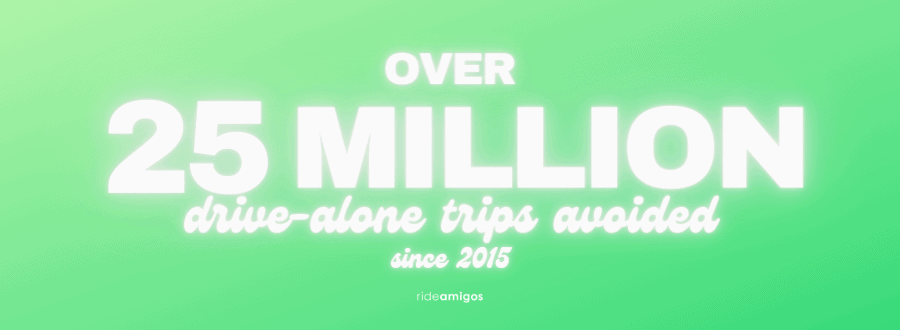Reflecting on 2020 & Looking Ahead
/0 Comments/in blog, Commuter Tips, Employers, GovernmentAt RideAmigos we are on a mission to change the way the world commutes for good by empowering everyone to make smarter transportation choices; and we partner with some of the most innovative employers and government agencies to do it.
Over the years, agencies and employers have used RideAmigos to help commuters choose an alternative to driving alone over 25 million times and eliminated 237 million pounds of CO2.
Looking back on the past year, we are so proud of how our partners each rose to meet the challenges brought by the pandemic, economic crisis, and continued reckoning with access and inequities in our mobility ecosystem.
Setting New Precedents
Overall in 2020, commuters used RideAmigos to report working remotely more than a million times in connection with employer or regional programs. They also logged just as many active trips, such as biking or walking, either to work or just to get outside.
Before the pandemic set in, agencies and employers using RideAmigos were replacing over half a million SOV trips per month in 2020 with active trips, remote work or shared modes.
Also in 2020 RideAmigos was part of a team that received an Association for Commuter Transportation Excellence in Research Award. The award recognized work with the City of Durham and Duke University’s Center for Advanced Hindsight to bring a personalized commute plan pilot to scale and through this helped organizations achieve a mode shift of up to 10%.
Taking Action in a Crisis
When the COVID-19 crisis began, agencies and employers used RideAmigos to communicate safe commuting guidelines. They also responded to changing circumstances with rapid adjustments to incentive programs.
As the pandemic continued our clients began to reimagine commuter engagement strategies. This included:
- Launching programs to engage a hybrid workforce of remote and essential onsite employees.
- Creating opportunities for community members who may have been unemployed or furloughed to stay engaged and learn about alternatives to driving alone.
- Challenging employees and the public to build new habits by biking-to-anywhere
2020 was a difficult year for the world and our community of transportation demand management (TDM) professionals was no exception. But we also came together in exciting ways. CommuteCon, always a virtual event, saw over 1,500 people join in. The April 2020 event was timed perfectly, providing a forum to discuss the unprecedented challenges and unique opportunities brought about by the pandemic.
Looking Ahead
We are continuing to work with our amazing customers as they reimagine the future with a reimagined commute experience for essential workers, future returns to the office, or hybrid work arrangements with smart parking management, subsidies and incentives, and other proven commuter behavior change programs.
We are continuously reinvesting in our products, and working to bring the latest insights from research into technology to our clients to create a better more sustainable commute experience.
2021 promises to be a year of transformational and regenerative change. We’re looking forward to working together to harness this moment to make an even greater positive impact on our communities and the planet. If you are interested in learning more about how commuter engagement can support your evolving workplace, contact us to get started.
How to Make Transportation Incentives Work Better on Limited Budgets
/1 Comment/in Benefits, blog, GovernmentTransportation incentives are programs local transportation and public transit authorities create to encourage people to choose alternatives to solo driving. They aim to achieve their objectives by giving commuters specific rewards for using smarter modes of transportation. Common examples include things like:
- Free public transportation on certain days
- Access to high-occupancy vehicle (HOV) lanes on highways
- Rewards programs
- Loyalty programs
- Access to preferred parking
- Free electric vehicle charging
While transportation incentives generally have a beneficial impact, default strategies have some noteworthy limitations. First, they tend to reward people who are already using smart alternatives to solo driving instead of encouraging single-occupancy vehicle operators to change to another mode. They also stagnate by failing to engage participants over the long term while offering financial rewards that do not provide enough motivation. Typically, this results from budgetary limitations.
So, how can you make transportation incentives more appealing without driving up their costs? We have identified four effective strategies:
- Targeted campaigns: Data-driven insights offer a cost-effective way to determine who is already participating in the preferred behavior and what groups can be targeted for a behavior shift. Don’t go after those who are already using smart alternatives. Instead, save your resources for those who aren’t.
- Randomness: Build participants’ anticipation for rewards through randomness: use techniques like raffles and draws for major prizes to get people excited about taking part. Randomness also helps fight program stagnation by introducing an element of excitement and uncertainty.
- Normalization and framing: Create sustained marketing and public awareness campaigns that frame smart alternatives to solo driving as normal, popular, and increasing in popularity.
- Self-image: People are motivated not only by financial rewards, but also by their identity. For example, cycling enthusiasts can often be convinced to start biking to work fairly easily. Knowing the identity characteristics of your target audience can give program effectiveness a big boost.
Our experts can suggest many other techniques and strategies to help make your transportation incentives that much more appealing while keeping your budget under control. If you would like a free assessment of your existing programs, the entire RideAmigos team is here to help you get started.
Why Cities Are Eliminating Traditional Parking Requirements
/0 Comments/in blog, Government, GovernmentIn North America, many municipalities have bylaws mandating the inclusion of parking facilities in new residential developments and commercial buildings. These policies, which date back to about the middle of the 20th century, once served important and practical purposes.
First, municipalities feared that a lack of adequate parking would put their businesses at a competitive disadvantage. This concern was especially prevalent in downtown areas of major metropolitan centers, which were economically threatened by the rapid rise of suburban development. Also, neighborhood residents tended to worry that they would have to compete with new neighbors for limited parking. As such, they were reluctant to support new high-density construction projects like apartment buildings and condominiums.
Parking requirements solved these issues, but they also supported over-reliance on privately owned vehicles. Thus, as cities continued to grow, traffic congestion and pollution continued to grow with them. They also contributed to urban sprawl, as the amount of space occupied by surface parking lots adds up quickly when aggregated across an entire metropolitan area.
In 2017, Buffalo became the first major city in the United States to repeal its municipal parking requirements. Many other cities, including San Francisco and Minneapolis, have since followed suit. In examining this trend, we are left with three interesting questions:
Why now?
Reduced reliance on private vehicle ownership is a major driver of the shift away from parking requirements. Cities are becoming acutely aware of the many negative impacts of traffic congestion, and many have responded with policies designed to make alternatives to solo driving more accessible and user-friendly. This is having a positive impact by making people less reliant on cars, which in turn makes parking requirements less feasible than they were in the past. As some observers have pointed out, parking requirements enabled urban addictions to cars, and getting rid of them will help cities break free.
In addition, developers lamented the financial and intangible costs associated with parking requirements, which not only take up precious space but also cost hundreds of thousands or even millions of dollars to fulfill. Eliminating these requirements reduces construction costs, which in turn allows more housing to be built. Getting rid of mandated parking also makes it easier for cities to embrace smart, high-density urban growth models by ensuring that prime real estate is not occupied by something so inessential as a parking lot.
How will eliminating parking requirements benefit cities?
The most obvious benefits will come in the form of increased residential density, reduced vehicle usage, and accompanying reductions in pollution and traffic congestion. However, there are also many other advantages:
- Lower rent rates. Because eliminating parking requirements increases available housing by reducing construction costs, housing becomes more affordable because supply levels rise. According to a 2016 study, parking requirements add an average of $1,700 a year in rental costs. Eliminating them could lead to big savings, especially for lower-income individuals.
- Developmental diversity. Meeting parking requirements puts limits on the types of buildings that can be constructed, as they necessitate certain architectural and functional characteristics. Getting rid of them allows developers to be more creative. For a few interesting examples, look to downtown Sandpoint, Idaho.
- Historical building preservation. In Buffalo, and many other cities, parking requirements led to the demolition of numerous historic buildings since they could not be redeveloped while meeting municipal zoning bylaws. Scrapping the requirements will make it easier to preserve and repurpose buildings that were constructed before parking requirement laws existed.
How will the changes impact residents?
The urban living landscape will begin to change as more and more cities rethink their parking requirement bylaws. Demand for smart solutions like carpooling, carsharing, and emerging mobility models like shared bikes and scooters will continue to grow. People will make more regular use of public transit, and cities will become more walkable as growth densities rise and updated building codes facilitate the creation of innovative mixed-use spaces.
Just as municipalities will need to respond by continuing to support the proliferation of alternative modes of transportation, employers will see an increased need to create effective commuter programs. Statistics show that long and difficult commutes frequently lead people to quit their jobs, and businesses will need to offer solutions that support recruitment and employee retention efforts.
RideAmigos can be a big help in these areas. Our innovative, comprehensive software platform provides an exhaustive list of administrative and management tools municipalities and businesses can use to make transportation alternatives more accessible. To learn more, get started with a demo or a free analysis of your existing commuter management strategy.
Charlotte Area Transit System (CATS) Takes Commuter Rewards to the Next Level
/0 Comments/in blog, Commuter Tips, Government, GovernmentIn December 2018, the Charlotte Area Transit System (CATS) launched a new commuter rewards program to the public. The CATS program allows commuters to earn points towards valuable rewards by logging smart commutes using approved alternatives to solo driving. CATS configured the system so that 10 round trips logged using approved modes could earn the commuter a $5 reward.
Just 10 days after launching, the CATS commuter rewards program attracted almost 200 new users, marking a 500% increase in registered users over the preceding three-month period. Over those 10 days, participants posted some pretty impressive stats: they logged 1,200 alternative trips totaling 14,900 miles, which saved 3.83 tons of CO2 emissions.
CATS program administrators used a few targeted approaches to generate interest in the program. First, they enticed new users by offering bonus points for joining, putting them within striking distance of a prize right off the bat. They also structured their program to include progressive reward tiers, giving participants added incentives for logging more trips and saving their points for a truly special prize. The resulting engagement and impact speaks for itself!
Learning from Programs that Work
The CATS program is powered by CommuteRewards, part of the RideAmigos cloud-based platform that automates the kinds of proven points programs that have worked for innovative employers like the City of Austin and regional agencies like Commute.org.
Key advantages of the CommuteRewards program:
- Easy management. By taking advantage of automation, the program eliminated the need to worry about how many rewards to purchase from each vendor at any given time. Instead, they simply define a budget and set point values. Earning and redeeming points is self-service!
- Tons of choice. Because more than 100 different rewards providers participate, there is no guessing which vendors commuters will like best. Everyone is different, so the program lets them choose their own rewards from a wide variety of retailers and restaurants.
- Streamlined administration. The CommuteRewards store is configured for easy administration, so you don’t have to keep track of digital codes, leftover gift cards from previous events, or other similar management and reporting headaches.
Commuter rewards are generally a great way to motivate employees to make better and more frequent use of greener, smarter alternatives. A growing number of companies and organizations are turning to this strategy to complement their outreach and commuter challenges and promote sustained behavior change. If you’d like to learn more, we’d be happy to help!
Congratulations to the 2018 ACT 40 Under 40!
/0 Comments/in blog, Education, Employers, GovernmentRideAmigos congratulates the 2019 class of 40 leaders in transportation demand management (TDM) under the age of 40. The Association for Commuter Transportation recognized these emerging professionals at the TDM Forum in Nashville, Tennessee in November.
This group of honorees represent the present and future of practice and advocacy for smart commuter transportation.
We are especially proud of our own Corey Tucker, Director of Customer Success, and Grant Heger, Director of Technical Services for being recognized this year.
We are also honored to work with so many of these brilliant professionals. Learn more about the 40 under 40 and read more about the recipients at actweb.org/act-40-under-40/.
Commuter Engagement vs. Commuter Management
/0 Comments/in blog, Education, Employers, Government, GovernmentAs competition to recruit and retain top talent grows tougher, a growing number of companies and organizations are offering commuter programs as part of their benefits portfolio. Two common phrases you’re likely to encounter include “commuter engagement” and “commuter management.” Many people are under the impression that these two terms are interchangeable, but there are actually important differences between these cornerstone concepts.
What is commuter engagement?
Commuter engagement focuses on programs that make people feel good about adopting alternative modes. In addition to promoting short-term commuter events like Bike-to-Work Month or Rideshare Month, effective engagement strategies also aim to encourage long-term behavior change. When handled well, commuter engagement results in more people choosing to ditch the solo drive in favor of smart alternatives more often.
Essential commuter engagement strategies and concepts include things like:
- Points programs that allow commuters to collect points they can later redeem for valuable rewards
- Games, friendly competitions, challenges, and other incentive programs
- Giving commuters financial incentives for leaving their cars at home, like those provided by parking cash-out programs
- Targeted marketing campaigns that promote commuter programs to specific groups within your organization
What about commuter management?
Commuter management, on the other hand, simply seeks to provide commuters with the information and resources they need to make better use of smart mobility options. It covers things like:
- Survey distribution and data analysis features to inform program planning
- Smartphone-powered trip planners for public transportation and ridesharing networks
- Rideshare matching systems
- Commute logging tools to track progress in challenges and incentive programs
- Network creation and reporting capabilities
RideAmigos empowers program leaders to successfully manage both commuter engagement and commuter management. Our unique, industry-leading platform includes the tools and programs that make it easy to drive higher levels of commuter engagement. Administrators also enjoy advanced commuter management features and that make managing and analyzing large and complex programs easy, efficient, and fun. To learn more about our solutions, get started with RideAmigos today!
Four Things To Watch for at the 2018 ACT TDM Forum in Nashville
/0 Comments/in blog, Education, Employers, GovernmentThe 2018 ACT TDM Forum is happening on November 13 and 14 in Nashville, Tennessee, and we’ll be watching it closely. The Association for Commuter Transportation (ACT) holds several conferences and events throughout the year in addition to its annual International Conference in the summer. This forum on transportation demand management (TDM) is a key opportunity for anyone working on commuter mobility and transportation in the private or public sector.
Just like last year’s event in Las Vegas, this one has an agenda focused on preparing TDM professionals to keep up with the latest changes in technology, policy, and the evolving mobility ecosystem. Starting with the opening keynote from Gary Gaston, CEO of Nashville Civic Design Center, it promises to be an inspiring two days. And like the other events organized by ACT, what happens at the TDM Forum is a great indication of where the industry is heading.
Whether you’ll be attending in person or not, here are the important things we think you should watch for:
Breakout Sessions
An impressive agenda is taking shape and we’re excited about the topics and panelists that are showing up. From new dockless scooters to big data, we’ll be splitting up to make sure we don’t miss any of the breakout sessions featuring leaders in TDM.
Kicking off the sessions on Tuesday morning, RideAmigos Director of Customer Success, Corey Tucker, will be moderating an important discussion of how organizations can leverage mobility data to make better operational decisions.
We’re also looking forward to hearing from Lucy Tice and Jessica Sanborn from Google talk about what drives commuter choices. While you’re counting down to Nashville, check out this Coffee Talk in which Lucy shared how Google incentivized employees to bike to work.
More sessions are still being added, so check out the full agenda here.
40 under 40
The ACT 40 Under 40 Awards recognize emerging leaders in TDM. According to ACT, “the awards provide recognition for ambitious leaders who are working to find creative TDM solutions to improve the quality of life of commuters and the livability of communities.”
Each year, the 40 under 40 represent agencies, companies, and academic institutions that are leading change. In 2017, five RideAmigos clients, including Peter Williamson, were among the honorees when awards were presented in Las Vegas. RideAmigos co-founder Jeffrey Chernick is also a past honoree.
We always keep an eye on this list of 40 industry trailblazers and the organizations they represent to learn from their success and see what they’ll do next.
Who Shows Up
If you were at the 2018 ACT International Conference in Anaheim, you probably noticed something: IT. IS. GROWING.
From innovative mobility providers and technology vendors to an ever-increasing number of organizations prioritizing commuter transportation programs, the new faces at each ACT event are signaling that TDM is starting to take center stage. Whether you have been working to solve commuter mobility challenges for decades or are new to the industry, you should see the growth of this amazing community as a really positive sign.
Don’t miss this and other opportunities during the year to hear from and network with industry thought leaders, commuter management professionals from around the world, and new mobility providers.
RideAmigos Updates
We recently released major updates to the RideAmigos mobile apps and commuter engagement platform. But we have lots more in store. Our team will be on hand in Nashville with some exciting things to show you. If you’re already a RideAmigos customer, you can also get early previews through Academy Office Hours webinar series.
If you’ll be coming to the ACT TDM Forum and you’d like to meet with our team, email act@rideamigos.com. If you can’t make it, you can contact us for a demo and consultation. Either way, we’d love to meet you to learn about your challenges and share some of what we’re excited about this Fall.
Five Things Every Employee Transportation Coordinator Should Know
/0 Comments/in Employers, Government
Doing these five things will help you optimize the employee commute experience on your company’s campus.
Employee transportation coordinators (ETCs) play a leading role in delivering commuter benefits to the members of a company or organization’s workforce. They also develop, implement, and update commuter programs and policies, and serve as internal and external “point people.” Yet, the role is also relatively new, becoming more widespread over the past few years.
Because the transportation demand management (TDM) landscape is constantly shifting as policies, technology, and best practices continue to evolve and change, ETCs need to stay focused and current to maximize their impact.
These are five of the most important things that every employee transportation coordinator should be doing now:
#1 – Get to know your local and regional commuter programs
Almost every major city or region has a government-affiliated commuter program that aims to promote alternatives to solo driving. These organizations work to empower commuters and lead the push toward smarter, more sustainable transportation choices.
As an ETC, you should be proactive about connecting and cooperating with local and regional commuter programs. Do more than just find out what they offer. Reach out to the people who run them, and get to know them. Attend their events and webinars, join their mailing lists, and stay engaged with what they’re doing.
Remember: an effective ETC is a company or organization’s in-house commuter programs expert. The most successful ETCs have advanced knowledge that reaches beyond their own walls and extends out into the broader community.
#2 – Stay current
On a related note, local and regional commuter management ordinances and programs can be complex, and they often have a lot of moving parts. They also tend to maintain long and detailed lists of requirements that partner companies and organizations are expected to meet. You could be dropped from the partnership for failing to meet even one of those requirements, even accidentally.
To that end, make sure to stay current with the details of all the local and regional commuter programs your organization participates in. If their requirements are changing, or if you’ve implemented organizational changes that may affect your eligibility, reach out to the appropriate administrators for help or advice. This is another incentive for maintaining close ties and open communication with your local program coordinators.
Plugging into organizations like the Association for Commuter Transportation that offer webinars, conferences and other learning opportunities at the local and international level is another great way to stay informed. And be sure to check out CommuteCon.com for information on upcoming virtual conferences for commuter management professionals.
#3 – Share commuter program info with new employees
Newly hired individuals often struggle to find their own way into commuter programs after starting a new job. It’s common for new hires to simply not know that commuter support options are available.
Coordinate with the person or team responsible for new employee orientations. Make sure they are mentioning internal commuter programs during welcome sessions, even if only briefly. Prepare materials that could be included in either printed or digital orientation packets. Then, make sure those materials contain your name, contact information, and a warm message that lets newcomers know you’re available and happy to answer any commute-related questions they might have.
#4 – Keep coworkers engaged and informed
Effective ETCs keep their coworkers engaged with commuter programs and informed about resources, opportunities, and special initiatives.
Here are a few strategies you can use:
- Create an email list that interested colleagues can join to learn more about programs and updates
- Generate and distribute posters and flyers about special events like annual commuter challenges
- Work with your human resources department to include commuter programs in new employee onboarding plans or and regular internal communications
- Do a lunch-hour presentation series on commuter-related topics, such as “Bike to Work 101” or “Ways to Get to Work Without a Car”
- Invite a representative from local or regional commuter programs to talk about their initiatives (and include an incentive for participating, like free lunch or a prize draw)
#5 – Take full advantage of available tools
First, look within your company or organization to see what tools and supports they offer. Does your company have its own carpooling network or ride-matching software? Is there a commuter rewards program in place already?
Many dramatic TDM success stories begin with creative and engaging commuter rewards, challenges, and friendly competitions. These are easy to implement and fun for participants, and they can really drive participation rates in the right direction.
If you’re a little short on the tech end of things, you can also reach out to local and regional commuter programs to see if they have any room to add your company as a network on their software. Of course, the entire RideAmigos team is also here to help you take full advantage of the impressive benefits of technologies like our signature commuter management platform.
Finally, remember: you’re not alone! Talk to other ETCs, be part of the RideAmigos Academy if you’re a customer, and don’t forget to check out the Association for Commuter Transportation.
RideAmigos Customers are Winners at 2018 Association for Commuter Transportation (ACT) Awards
/0 Comments/in Education, Employers, Government
On August 1, the Association for Commuter Transportation (ACT) hosted its 2018 international conference. This year’s gathering was held in Anaheim, California, and during the event, 15 individuals or organizations received awards for their outstanding achievements in transportation demand management (TDM). The entire RideAmigos team is excited to announce that eleven of the twenty-nine ACT Award finalists and four of the winners use RideAmigos to power their innovative commuter programs.
First, the Parking Services division at California State University-Los Angeles copped a Marketing and Outreach award for its successful efforts to promote alternatives to solo driving, implement forward-thinking commuter projects and policies, and reduce the local environmental impact of commuting.
Next, the City of Austin Smart Commute Rewards program earned an award in the Commuting Options category. This program allows city employees in the fast-growing city of Austin, Texas earn rewards for logging commutes with solo driving alternatives. The program’s manager, Tien-Tien Chan, said, “We are honored to be selected for this award,” and added that, “I find it immensely valuable to see how other companies and jurisdictions are creatively tackling the problems that we all face.”
Third, Go Redmond won in the Commuting Options – Biking category. The initiative is a partnership between the Greater Redmond Transportation Management Association (GRTMA), King County Metro, and the City of Redmond, and it aims to increase bicycle ridership year-round as a commuting alternative. Go Redmond also provides a wealth of informational resources to people and organizations looking to reduce their carbon footprint while embracing smarter transportation alternatives.
Finally, the University of California-Los Angeles (UCLA) Transportation department captured the Commuting Options – Public Transportation award for its intensive efforts to make public transit, cycling, carpooling, and vanpooling more accessible to its commuter base of 80,000 staff and students.
All four of these organizations rely on the revolutionary, tool-rich RideAmigos platform to create, administer, and power their commuter programs. We’d be proud to be a part of your success story in 2019. Get started with RideAmigos today, and improve mobility, sustainability, and organizational health and wellness by putting the power of our cutting-edge software to work for your organization.







